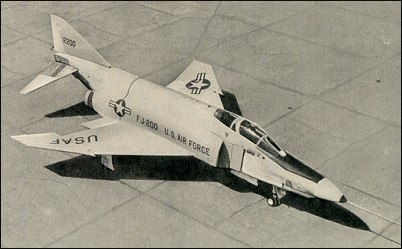 |
McDonnell Douglas F-4 Phantom II1958 |  |
| FIGHTER | Virtual Aircraft Museum / USA / McDonnell Douglas |
 |
For a quarter-century, the McDonnell F-4 Phantom II has risen from land and sea to take command of the air, to carry out the strike mission, to fight MiGs, and to join the Thunderbolt, Mustang and Sabre among the immortals of American fighter aviation. Its bent wings, drooped tail and twin-engine configuration a trademark, the Phantom was the first aircraft which could detect, intercept and destroy any target within its radar range without assistance from surface-based radar. Built as an interceptor, it became a MiG killer, but it also excelled at ground attack, 'fast FAC', reconnaissance, and other duties. The F-4A (US Navy F4H-1F) was a developmental variant, the first making its maiden flight at St Louis on 27 May 1958. It was followed by the US Navy's operational F-4B (F4H-1), powered by two 7711kg afterburning thrust General Electric J79-GE-8 engines. The F-4B model attained an altitude record of 30040m on 6 December 1959, a speed record of 2585km/h on 22 November 1961, and a low-altitude speed record of 1452km/h on 20 August 1962, the last-named not being beaten for 16 years! The EF-4B designation went to one airframe used for ECM training, and two modified, development airframes bore the NF-4B designation. The QF-4B is a drone conversion. The RF-4B reconnaissance derivative served only with the US Marine Corps. The F-4C (F-110A) was the US Air Force's first Phantom, the first example being flown on 27 May 1963. The F-4C became operational with the 12th and 15th Tactical Fighter Wings at MacDill AFB, Florida, in January 1964. Some 583 were built, 40 being transferred to Spain. The service-test YRF-4C (YRF-110A) led to the RF-4C (RF-110A), 499 of which were constructed for the photo-reconnaissance role. The F-4D Phantom fighter-bomber introduced a capability to deliver precision-guided munitions (PGM), or 'smart' bombs. Some 825 were built, including 32 delivered new to Iran and 36 transferred to South Korea. Once in action in Vietnam in 1965, the Phantom seemed to need a gun to augment its missile armament in close-quarter battles with MiGs. The SUU-16/A 20mm external gun pod was an interim measure. The F-4E, first flown on 7 August 1965, introduced more powerful J79-GE-17 engines but its principal change was the internally-mounted M61A1 20mm cannon. Although superior pilot training would later prove more important than the cannon in establishing a 2.5-to-1 kill advantage over North Vietnamese MiG-17, MiG-19 and MiG-21 fighters, the F-4E became the definitive Phantom, and 1,397 rolled off the line. Examples were supplied to Australia (on loan), Greece, Iran, Israel, Turkey, South Korea and West Germany; and 140 F-4EJs were licence-built by Mitsubishi in Japan. The RF-4E was an export reconnaissance derivative, supplied to Greece, Iran, Israel, Japan and West Germany. By the mid-1960s, the Phantom was just about the best-known fighter in the world. On 2 January 1967 in Operation 'Bolo', F-4Cs of the 8th TFW under Colonel Robin Olds shot down seven North Vietnamese MiGs. Increasingly, F-4Ds took over from the Republic F-105 the job of bringing ordnance to bear on Vietnamese ground targets. Visitors to St Louis, where McDonnell took over Douglas in 1967, wanted not merely to see the heavy, complex fighter put together by Herman Barkey's design team, but to buy it. The F-4F was a specialised air superiority version for the West German Luftwaffe, and 175 were delivered. The F-4G designation had been used initially for 12 aircraft taken from the US Navy F-4B production line. They had the two-way ASW-21 data-link system for automated carrier landings, and all later reverted to F-4B standard. In the 1970s, the F-4G appellation was used again for the US Air Force's 'Advanced Wild Weasel' electronic warfare aircraft, 116 of which were converted from F-4E standard. Originally seen as a counter to enemy SAM missile sites and associated radars, the F-4G now carries out a wide portfolio of electronic missions. Aircraft are stationed as far afield as the 3rd TFW Clark Field, Philippines, and 52nd TFW, Spangdahlem AB, West Germany. The F-4J was an improved production fighter for the US Navy with 8119kg afterburning thrust J79-GE-10 engines, enlarged wing and improved avionics. The F-4K was developed for the UK's Royal Navy and the F-4M for the Royal Air Force, though both are now operated by the latter service which, with expanded commitments following the 1982 Falklands war, has also inherited 15 ex-US Navy F-4Js. The F-4N is an upgraded 'rebuild' of the F-4B, and has in turn been converted to the QF-4N drone. The F-4S is an upgraded F-4J with wing manoeuvre slats and was the final Phantom variant to serve aboard an aircraft carrier, with VF-151 and -161 aboard the USS Midway. Phantoms serve widely with the Reserve and Air National Guard and are likely to remain in front-line service with some air forces into the 21st century. McDonnell Douglas F-4 Phantom II on YOUTUBE

|  COMPANY PROFILE | ||||||||||||||||||||||||||||||||||||||||||||||||||||||
 |

|

